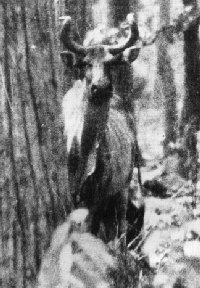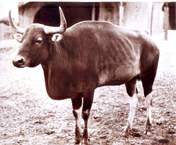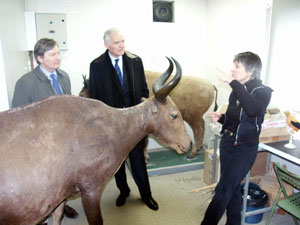
September 17, 2006

One of the first photographs taken in the wild of the elusive kouprey.
Kouprey (Bos sauveli), a wild forest-dwelling ox, was discovered in 1937. (Indeed, the kouprey is discussed as an animal of discovery in cryptozoology, on page 128, here.)
The 250 or so living kouprey are located in northern Cambodia and apparently also in western Vietnam, southern Laos, and eastern Thailand. The few kouprey found in Thailand, for example, were believed extinct for over two decades, and only rediscovered in the 1990s. In 1994, scientists began paying attention to lore about a possible second species of kouprey, a smaller version. More information needs to be gathered about them. Kouprey mysteries remain.

This photograph (above) was taken in 1937 of a kouprey at the Vincenes Zoo, Paris; the animal died in 1940.
But a recent report published by Northwestern University scientists (Gary J. Galbreath, the lead author and two others) in London’s The Journal of Zoology indicate that a comparison of mitochondrial sequences shows the kouprey to be little more than a hybrid between a zebu (Bos taurus indicus, formerly Bos indicus), the famed humped cattle of India, and a banteng (Bos javanicus), a wild ox of Southeast Asia and Indonesia.
There is a dispute, however.
This week the New York Times overviewed this debate, noting the:
…three biologists from Northwestern University and the Cambodian Forestry Administration have proposed a taxonomic demotion. In a paper published online in July by The Journal of Zoology, they say the kouprey is probably a domestic hybrid that became feral, a zoological poseur, not a valid species.
The biologists‚ proposal has met stiff opposition within the small group of scientists who study Asian wild cattle. Several say the paper misinterpreted the genetics and history of the kouprey, which may still exist in domesticated form. Although rare, elusive and enigmatic, kouprey are recognizable enough, longer-legged, more graceful, faster and slightly larger than the closely related banteng, and slightly smaller than the gaur, the largest of the wild cattle.
and later in the article:
[The] two French scientists, Alexandre Hassanin and Anne Ropiquet of the National Museum of Natural History in Paris…have fired back. In a recently submitted paper, they argue hypothetically that if the Cambodian banteng represents a separate species from the Javan banteng, then the kouprey could have derived from the Cambodian version, as the Galbreath team proposes. But it was more likely, Dr. Hassanin said in an e-mail message, that the kouprey was a natural species that evolved in Southeast Asia. On at least one occasion more than 100,000 years ago, a kouprey mated with a banteng. Their descendants are Cambodia‚s banteng, with mitochondrial DNA more closely resembling kouprey than banteng.
To complicate matters further, last February Dr. Hassanin and other colleagues published a paper in the journal Comptes Rendus Biologies arguing that a specimen mounted in 1871 in Paris and thought to be a domestic ox from Indochina was, in fact, a domesticated kouprey. The specimen has been at the museum in Bourges since 1931.
Dr. Hassanin said several indigenous Asian breeds of cattle might be derived from kouprey. Herds, especially in Cambodia, should be tested to see whether any are pure kouprey, Dr. Hassanin and his colleagues said, adding that if they are, steps should be taken to preserve them.
Where Dr. Hassanin sees pure kouprey, Dr. Galbreath finds his banteng-zebu hybrid. Independently, both say that more extensive sampling and analysis of mainland banteng are needed to determine who is correct. Commenting on the papers, Simon Hedges, an Asian cattle specialist with the Wildlife Conservation Society who was not involved in either study, tended to agree that the Cambodian banteng had probably hybridized with the kouprey. But he also suggested that the kouprey both groups studied might itself have been a banteng-kouprey cross.

The above pictured kouprey is the misidentified animal that arrived at the menagerie of the botanical garden of Paris in 1871. After its death, it was mounted and placed in the Natural History Museum of Paris, before being entrusted in 1931 to that of Bourges. Its heading: “Ox of Kampuchea, gift of the Minister for the Navy.” (Kampuchea is another name, used by some, for Cambodia.)
Only in October 2003, did questions arise about this ox. Indeed, at the time of the Conference of Mammalogy organized in Bourges, the person in charge for the collections of the National History Museum was intrigued by this ox resembling no specimen which he knew. Following this opinion, the natural history museum decided to investigate the identity of this animal. An analysis DNA made it possible to identify this ox: it is a kouprey of male sex. The purity of the animal has raised several questions about later DNA analysis, such as done by the Northwestern University team. The debate about the kouprey is anything but cold.

There apparently is a kouprey in this photo. Can you see it? This gives you an idea of how elusive the kouprey was until technically discovered by Western Science in 1937 – and still is. Now the debate as to the status of the kouprey serves to add another level to the enigma of the animal.
About Loren Coleman
Loren Coleman is one of the world’s leading cryptozoologists, some say “the” leading living cryptozoologist. Certainly, he is acknowledged as the current living American researcher and writer who has most popularized cryptozoology in the late 20th and early 21st centuries.
Starting his fieldwork and investigations in 1960, after traveling and trekking extensively in pursuit of cryptozoological mysteries, Coleman began writing to share his experiences in 1969. An honorary member of Ivan T. Sanderson’s Society for the Investigation of the Unexplained in the 1970s, Coleman has been bestowed with similar honorary memberships of the North Idaho College Cryptozoology Club in 1983, and in subsequent years, that of the British Columbia Scientific Cryptozoology Club, CryptoSafari International, and other international organizations. He was also a Life Member and Benefactor of the International Society of Cryptozoology (now-defunct).
Loren Coleman’s daily blog, as a member of the Cryptomundo Team, served as an ongoing avenue of communication for the ever-growing body of cryptozoo news from 2005 through 2013. He returned as an infrequent contributor beginning Halloween week of 2015.
Coleman is the founder in 2003, and current director of the International Cryptozoology Museum in Portland, Maine.
Filed under Breaking News, CryptoZoo News, Cryptozoology, Forensic Science